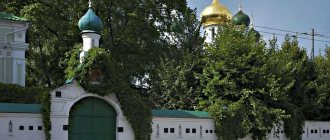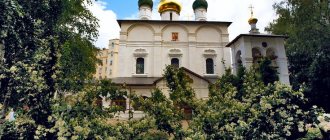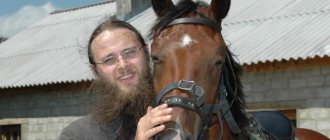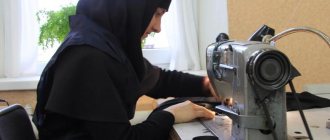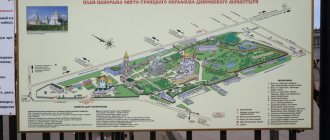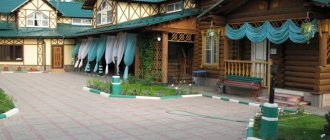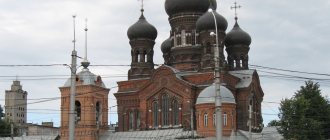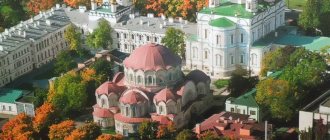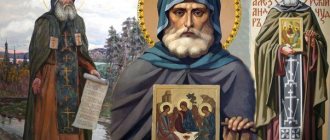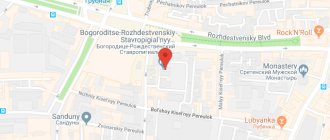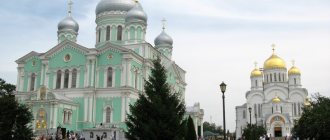The oldest Orthodox monastery in the center of Moscow is the Sretensky Monastery. In 1612, he played an important role in the election of Mikhail Romanov to the kingdom, providing shelter to the people's militia led by Dmitry Pozharsky. And in the Soviet years, Luka Voino-Yasenetsky became an involuntary inhabitant of the monastery - the prisoner was in an internal prison on Lubyanka. These and other details are in our article.
Address of the Sretensky Monastery in Moscow
Address of the monastery: st. Bolshaya Lubyanka, p. 19.
Metro
Stations nearby are:
- "Chistye Prudy";
- "Sretensky Boulevard";
- "Kuznetsky Most";
- "Turgenevskaya";
- "Pipe Square";
- "Lubyanka"
How to get there:
- From the Lubyanka and Kuznetsky Most metro stations you can walk or take bus C633 to the stop. "Sretensky Gate"
- From the Chistye Prudy, Sretensky Boulevard and Turgenevskaya metro stations you can only walk, following Sretensky Boulevard towards Bolshaya Lubyanka.
- From the Trubnaya Ploshchad metro station you can also walk along Rozhdestvensky Boulevard to Bolshaya Lubyanka.
- Those who come to the capital by train and get to the Square of Three Stations can use bus route C633. The bus leaves from Komsomolskaya Square. You need to get off at the Sretensky Gate stop.
Sretensky Monastery: opening hours
For parishioners and pilgrims, as well as for numerous tourists who want to visit this blessed place, the doors of the monastery are open daily from 7 to 20 hours.
Schedule of services
On weekdays, morning services usually begin at 8 am. On Sundays and great holidays - an hour earlier. On Sundays, two Divine Liturgies are held here - Early (at 7.00) and Late (at 10.00).
Evening services usually begin at 18:00.
The schedule for the start of services can be found on the monastery website: Schedule of services (monastery.ru)
Patronal holidays of the Sretensky Monastery
Every year on September 8, the monastery solemnly celebrates the Presentation of the Vladimir Icon of the Mother of God - an event in memory of which grateful Muscovites built this monastery many centuries ago.
Throne service on the day of the Presentation of the Vladimir Icon of the Mother of God in the Sretensky Monastery on September 8, 2022. Photo by Anatoly Goryainov
In the ancient Sretensky Cathedral there is a lower church of the Resurrection of Christ. In addition to it, the cathedral has a limit of the Nativity of John the Baptist - an event celebrated on July 7, and a new limit in honor of the ascetic of the 5th century. St. Mary of Egypt, whose ascetic labors the Church glorifies on April 14, as well as in the fifth week of Lent.
The second cathedral of the monastery also includes two churches. The upper one is dedicated to the Resurrection of Christ and the new martyrs, whose tragic life feat is honored by the Orthodox either on February 7, if this date falls on a Sunday, or on the nearest Sunday to this day. The lower church of the cathedral is dedicated to St. John the Baptist and the Twelve Apostles, whose council is celebrated on July 13.
Church of the Resurrection of Christ and the New Martyrs and Confessors of the Russian Church. Photo by Irina Mosina
How to get there
The Sretensky Stavropegic Monastery is located on Bolshaya Lubyanka Street, 19. The easiest way to get to the monastery, located almost in the center of the capital, is by public transport.
Metro
Residents of the capital and tourists can use the metro. The closest metro stations to the monastery are:
- Lubyanka and Chistye Prudy (red line);
- Turgenevskaya and Sukharevskaya (orange line);
- Sretensky Boulevard (lime branch).
From Sretensky Boulevard, Turgenevskaya or Chistye Prudy stations, walk to Sretensky Gate, turn left onto Bolshaya Lubyanka. On the right in the direction of travel is the Sretenskaya monastery. The walk will take 10-15 minutes.
From the Lubyanka station you need to walk along the street of the same name towards the Boulevard Ring. After about 10 minutes, the walls of the monastery will appear on the left side. From the Sukharevskaya station you should exit onto Sretenka Street, turn left and walk towards the center of the capital. Cross the Boulevard Ring and continue along Bolshaya Lubyanskaya Street to the monastery.
History of the Sretensky Monastery
In the middle of the 12th century, rural arable land was located here. Their owner was the boyar Semyon Kuchka (or, as he was sometimes called, Kuchok), which is why the surrounding residents nicknamed this area the Kuchkov Field.
When Moscow grew, citizens began to gather here. At this place they listened to princely decrees, ruled the court, and elected thousands. And when at the end of the 14th century. The Mongol conqueror Tamerlane, having ravaged the Ryazan lands, moved towards Moscow, and the entire city gathered again on Kuchkovo Field.
Our Lady of Vladimir with 64 stamps “Tale of the Meeting of the Icon of Our Lady of Vladimir”
Here, on August 26, 1395, the townspeople, led by Saint Cyprian, met the miraculous face of the Vladimir Mother of God, which was carried here from Vladimir in their arms to protect the city from Tamerlane’s countless hordes. Doctor of Science Natalya Narochnitskaya explains:
“The religious procession then went on for ten days, and all the people prayed on their knees for the salvation of Rus', the Faith and the Church. Records from that time say that when the icon came to Moscow, “the whole city went out to meet it.” And to this day, secular historians cannot find an explanation why Tamerlane removed his camp a day later and went home. According to Tradition, the Mother of God appeared to him - “The Magnificent Woman surrounded by an angelic army,” and strictly ordered him to stop and leave. This is how church history interprets it.”
In 1397, at the site of the meeting of the face of the Heavenly Intercessor, this amazing monastery was erected by the grateful residents of Moscow.
Church of Mary of Egypt. View from the courtyard of the Sretensky Monastery in 1923. The church “on Kuchkovo Pole” - 1385, was older than the monastery. In 1883, its body was covered with ties to strengthen the structure. In 1930, the oldest building was demolished.
On May 21, 1521, another famous religious procession with the Vladimir Icon of the Mother of God took place in the city, captured in the church archives. That year, the Crimean Khan Mehmed I Giray (Girey) wished to resume receiving tribute from the Moscow state, as was the case during the Golden Horde. He was joined by the Lithuanians at war with Russia, and the total number of the enemy army reached one hundred thousand people.
Interesting fact
The chronicles of that period preserved evidence of two visions: to St. Basil the Blessed and to a certain blind nun from the Ascension Monastery. It was revealed to them how the Moscow saints, because of the impiety of the inhabitants, carried the Vladimir icon out of the city, and only through the tearful petitions of St. Varlaam Khutynsky and St. They returned the miraculous face of Sergius of Radonezh. Word of this reached the Metropolitan and Grand Duke Vasily III, as a result of which it was decided to convene a religious procession and serve a prayer service at the Sretensky Monastery.
The Heavenly Lady interceded for the townspeople, and Khan Mehmed I Giray retreated from the walls of Moscow. He turned his hordes to Ryazan, where he was met by a well-fortified militia armed with cannons. After an unsuccessful campaign, the khan was forced to leave Russian borders forever.
In the Church-Museum of St. Nicholas in Tolmachi
Nowadays, the wondrous face of the Mother of God, which saved Moscow from foreign invasion, is located in the house church of the Tretyakov Gallery - the Church of St. Nicholas in Tolmachi. The shrine is protected by an impenetrable icon case, inside of which constant temperature and humidity are maintained.
During the Time of Troubles, the headquarters of the Russian militia led by Dmitry Pozharsky was located in the Sretenskaya monastery. The prince, who was wounded in a battle with the enemy, received help here. And after the liberation of the state from the Polish conquerors, the first tsar from the Romanov family, Mikhail Feodorovich, was met within the walls of this holy place.
After the Patriotic War of 1812, it was decided to reconsecrate the desecrated Moscow shrines. The first newly consecrated Moscow church was the ancient Sretensky Cathedral.
Soviet years
During the years of theomachism, the location of the monastery played a role. Since it was located on Lubyanka, after its abolition in 1926, its buildings almost immediately became the property of the state security agencies.
Sretensky Monastery 1957 Moscow, Central Administrative District, Meshchansky district
Bishop Tikhon (Shevkunov) said:
“Do you know that Father John Krestyankin was also a resident of the Sretensky Monastery? Patriarch Sergius, Saint Luke Voino-Yasenetsky, Father Seraphim Tyapochkin, Patriarch Tikhon - all of them are inhabitants of the Sretensky Monastery, because they were all imprisoned here in the internal prison on Lubyanka.”
The restoration of the monastery began in 1993. The temple was abandoned at that time; it was not even separated by a fence from the roadway. Since 1994, continuous construction took place on this territory: the fraternal buildings, the refectory, and the seminary building were rebuilt.
Vladyka Tikhon recalled this:
“My confessor, Father John Krestyankin, once blessed me to build a courtyard for the Pskov-Pechersky Monastery, where I began to serve, in Moscow. We began to select a temple. Father John said: “Don’t take big churches. And don't take the first two either. There will be a third one, you’ll take it!” They showed me a large temple in Izmailovo, then another one, and then a “temple” in the former Sretensky Monastery. I knew nothing about the history of this place then...
Everyone who could came and helped. Gradually, novices began to gather and tonsures began. At first there was one small room, then another one was added. And then the monastery gradually began to take on the shape that it now has. Our monastery is the smallest, but the most densely populated.”
Abbots (vicars) of Sretensky Monastery
The rector is Hieromonk John (Ludishchev), since August 25, 2022, fulfilling this obedience by decree of His Holiness the Patriarch. He has been working at the Sretensky Monastery since 1999.
At one time, the monastery was also headed by Metropolitan of Tver and Kashin Ambrose (Ermakov) (until the summer of 2022) and Metropolitan of Pskov and Porkhov Tikhon (Shevkunov) (until the spring of 2022)
Relics of Hilarion
Particularly revered in the Sretensky Monastery are the relics of the Hieromartyr Hilarion.
Hilarion was born in 1886 into the family of a clergyman in a village located in the Tula province. All his life he studied diligently, was engaged in scientific works, and became a monk in 1913.
After the revolution, Hilarion did not reject his faith and continued to conduct services and work on historical works. In 1921, he was arrested, the reason for which was the organization of a crowded prayer service within the walls of the Sretensky monastery.
After spending a short time in prison, the archbishop was released and again taken into custody two years later. After several years on Solovki, Illarion was sent to Kazakhstan. On the way, he was robbed, and he, suffering from typhus, ended up in Leningrad.
In December 1929, the 43-year-old archbishop died in delirium. Dying, he insisted that he had found the long-awaited freedom. During the funeral service, it was impossible to recognize the former Hilarion in the exhausted old man.
A year before the beginning of the 21st century, the archbishop was canonized and his holy remains were transferred to the Sretenskaya monastery. Memorial Day – December 15th.
Life today
Metropolitan Tikhon said the following about today’s monastic life:
“The very location of the monastery dictates our obedience. First of all, this is spiritual activity. We have 26 priests who minister to a huge number of people. Confession on Saturday and Sunday can last until late at night. The second obedience is educational. Our website “Pravoslavie.ru” is visited by more than one hundred thousand people every day.”
There is a seminary on the territory of the monastery. Initially, it was organized here in order not to send monks, whose labors the monastery needed, to study at the Trinity-Sergius Lavra. Now there are about 250 students studying here, helping both in conducting worship services and in household work. Future ministers also work in the subsidiary farm of the monastery monastery.
Educational and Youth centers and catechesis courses have been created here. There is a Sunday school.
Shrines of the monastery
A special relic is an exact copy of the Shroud of Turin, which resides here with the blessing of Patriarch Alexy II.
Here there is a particle of the Life-giving Cross of the Lord, on which the Redeemer was crucified.
In 1995, a Worship Cross, created by sculptor V. Klykov, was installed at the entrance in memory of the executions of Christians carried out in this territory.
Relics, icons
Before the revolution, the main value of the monastery was considered to be a copy of the Vladimir Icon of the Virgin Mary, created in 1514 . Today this image has been transferred to the Cathedral of Christ the Savior. In the monastery at the present time there is another revered list. It was created in the 19th century. and belonged to the elder of the Pskov-Pechersk monastery, Archimandrite John Krestyankin. This icon is his blessing to those working to recreate this place. Bishop Tikhon (Shevkunov) explained:
“This is an icon from his cell. This is the icon in front of which Father John prayed for at least three decades.”
Another unique relic is the relics of the microwave oven. Hilarion (Troitsky) - an outstanding theologian, abbot of the Sretensky monastery in the era of revolutionary changes, comrade-in-arms of Patriarch Tikhon. Vladyka went through prisons, the Solovetsky camp and died in 1929. Above the shrine with the honest body of the ascetic his face is depicted surrounded by other new martyrs. Bishop Tikhon shared his memories:
“During the period of my churching, this was my most favorite saint, along with Patriarch Tikhon. How cheerful and courageous he is! How he is never discouraged, unshakable, and, at the same time, not proud. The most amazing person! Excellently educated. The entire life of the holy martyr was connected with Moscow. Here he was born, studied, and was a bishop. He wanted to be here... We serve fraternal prayers in front of his relics, which have now been transferred to the new cathedral. And we established the reliquary on stones from the Solovetsky Monastery, which were the steps of the Transfiguration Cathedral, along which the martyrs climbed when they went to this cathedral.”
In 2004, the relics of St. Petersburg were brought here from Greece. Mary of Egypt. They are installed in the area of the ascetic in the Sretensky Cathedral.
Relics of Mary of Egypt in the Sretensky Monastery
There are reliquaries with particles of the relics of many saints: St. Andrew the First-Called, St. George the Victorious, Ephraim the Syrian, St. Nicholas the Wonderworker, Seraphim of Sarov, Patriarch Tikhon and other devotees of piety.
Temples, chapels, farmsteads, monasteries
In 1385, a wooden church of St. St. stood on this site. Mary of Egypt. It was here, according to legend, that the residents of the city met the Vladimir Icon. In the 16th century, a stone building was erected on the site of the wooden structure, which stood until 1930.
The demolished bell tower of the Sretensky Monastery. Photo by Nikolai Naydenov, 1882
In 2009, one of the premises of the Church of the Presentation of the Vladimir Icon of the Mother of God was consecrated in honor of the holy righteous woman. Hieromonk Luke (Aule) , head of the monastery’s IT department, said:
“In 1997, we were loading books, and I saw a small akathist. The content included an akathist to St. Mary of Egypt. And then we composed a prayer service for her, which, by the Grace of God, we have served every Sunday after the evening service for the past 20 years.”
The Church of the Resurrection of Christ and the New Martyrs was consecrated in 2022. Bishop Tikhon (Shevkunov) explained:
“We named the temple in honor of the Resurrection of Christ precisely because it was the period of the revival of the Russian Church almost from the ashes, and in honor of those people thanks to whom we preserved the faith - in honor of the new martyrs.”
Even the wall paintings of the cathedral are dominated by lush green color, symbolizing the awakening of living nature.
The temple was erected in record time. Bishop Tikhon donated all the funds from his famous bestseller “Unholy Saints” to the construction. The height of the building is 61 meters. It has several floors and silent elevators. The total area of temple frescoes is more than 6 thousand square meters. meters. They were carried out by a team of 30 artists.
Cathedral of the Presentation of the Vladimir Icon of the Mother of God
The cathedral was erected at the end of the 17th century. Restorers were able to clear and restore ancient frescoes in it, including a unique painting from 1707, “Christ Heals the Man Born Blind.”
Cathedral of the Presentation of the Vladimir Icon of the Mother of God
At one time, there was a dormitory for NKVD workers here, and valuable works were saved from destruction only by the fact that they were covered with wallpaper. One of the masters who painted the building was the famous Leonty Fedorov , a Yaroslavl painter who decorated the temples of the Tolga Monastery. Restorer Alipiy Baldin, who is working on the restoration of this temple, makes a figurative comparison:
“Painting is a sermon in colors. In Rus', painting has always been a holiday for worshipers.”
The painting of this cathedral is also unique in that it is the only painting in the capital created during the reign of Peter I.
St. Seraphim Monastery
The monastery is located in the Ryazan region, not far from the city of Mikhailov, in the former estate of Catherine II’s favorite, General Alexander Ermolov. A subsidiary monastery farm for the brethren was organized here: vegetable gardens, vegetable greenhouses, premises for livestock and chickens.
The inhabitants had to work hard to make the monastery look well-groomed: cultivate abandoned collective farm fields, plant fruit trees, restore buildings, and restore the historical estate. The inhabitants of the monastery help a nearby boarding house for troubled teenagers.
Shrines
Several shrines revered in the Orthodox world are kept on the territory of the Sretensky Monastery.
- A revered miraculous copy of the icon of the Vladimir Mother of God.
- A particle of the relics of St. Mary of Egypt, which are kept in the chapel of the same name in the Sretensky Church.
- An exact copy of the Shroud of Turin, which has been kept in the crypt of the main monastery church since 1997.
- The relics of the Hieromartyr Hilarion (until 2022 they were in the Sretensky Cathedral, and after the consecration of the temple in honor of the New Martyrs of Russia they were transferred to the new church).
- Icon of Seraphim of Sarov with a particle of relics.
Interesting! In the cathedral church of the monastery there is a shrine in which the relics of St. Hilarion were kept until 2017. The parishioners of the temple continue to venerate her and receive miraculous help.
Monks
Those who decide to connect their lives with the monastery pray here not only for the salvation of their own soul, but also for every Orthodox Christian. Since many pilgrims visit this place every day, obediences are very clearly distributed among the inhabitants. Viceroy Hieromonk John (Ludishchev) explains:
“First of all, these are liturgical obediences. These are the obediences of the sacristan, who makes sure that the vestments are worn and the temple is clean and in proper condition. Then the obedience of the dean, who monitors compliance with the Charter of the monastery.
Economic service in charge of routine repairs and housekeeping work. Prosphora, which Father Cyprian handles for us. The brethren also have the opportunity to serve night liturgies at their own discretion, notifying the dean.”
The monastery has developed a tradition of “fraternal services”, at which all the monks are present. Thursday was chosen for such services, the day on which the Lord established the Eucharist.
Requirement cost
Religious rites performed according to the demands and requests of believers are called requirements performed in various faiths. Requirements are not included in the mandatory daily schedule of services.
It is better to find out the amount of fees for services according to requirements or notes directly in the temple.
Approximate amounts of donations for services performed for health or repose:
- mass, including 10 names in 1 note - about 20 rubles;
- Magpies for 1 name about 150 rubles;
- prayer service and service for the deceased, containing 10 names in 1 note - 30 rubles;
- psalter of prayer chants 1 name from 200 to 2000 rubles, depending on the number of days for which it is ordered.
Sretensky Monastery Publishing House
The publication of educational literature is an important activity of the monastery. Books printed in the monastery can be found in almost every parish library.
The publishing house has existed since 1993. Editor-in-Chief Maria Georgievna Zhukova recalls:
“When the publishing house was created, there was a great spiritual hunger among people. There were few books, but there was a very great need for reading books of spiritual content. First of all, prayer books, Holy Scripture, holy fathers. The publishing house was then located in two rooms, there were few employees.”
Mikhail Rodionov , head of the production department, also shares his memories:
“In the 90s, it was very difficult to buy anything Bible People read the “Lives of the Saints” from the pre-revolutionary edition, the Holy Scriptures, and the Ladder. Everything was with yats and solid signs. We needed something in Russian, with a new spelling. At this time, the translation of books from the old spelling to the new and the publishing of a block of patristic books began. We began to pay a lot of attention to publishing children’s literature.”
Today, along with theological and spiritual-educational literature, books of historical and artistic content, as well as encyclopedias and textbooks are created here. Every year more than 100 titles of books of various genres are published with a total circulation of up to 3 million copies.
Choir and chants
All monastery churches have excellent acoustics. This effect was achieved using highly professional equipment. Every word of the clergyman is heard here very clearly.
The monastery choir is known not only in the homeland, but also outside the state. And not only thanks to divine chants. The group's repertoire includes works of Russian folklore, as well as songs from the front-line years. Choir director Nikon Zhila explains:
“For us, these songs contain the idea of preaching not only within the Church for a believer, but simply for a person. These songs can be called the prayer of a secular person, because they are about the most important things: about friendship, about faith, about honor, about love - about what our society cannot and should not live without.”
The seminar choir, according to experts, sounds no worse than the professional choir of the monastery. Students also give concerts and participate in religious services. Hieromonk Afanasy (Deryugin), dean of the monastery, explains:
“All festive services are sung by two choirs: our famous monastery choir and the choir of the Sretensky Seminary.”
Selected chants of the Sretensky Monastery choir
We invite you to watch the video and listen to: Rachmaninov. “All-Night Vigil” performed by the choir of the Moscow Sretensky Monastery.
Educational courses
The courses opened at the monastery in 2014. They are conducted in the conference hall and other classrooms of Sretensky Seminary with simultaneous video recording, which is then broadcast on the Internet portal. Each such post is watched by an average of 30,000 people.
The lectures discuss many Orthodox issues: features of the interpretation of the Bible, the subtleties of Russian dogma, the history of the formation of the Church. Classes are taught by seminary teachers, clergy and laity.
Children's courses are held at the Educational Center. The head of the center, novice Mark Sikoev, explains:
“We hold completely different events. Here children can play games and meet with teachers. There are six studios in the center and all of them are themed to make it very pleasant to be there. Great importance is paid to creative disciplines, where children open up and do something with their own hands.”
Tatyana Rasnovskaya
